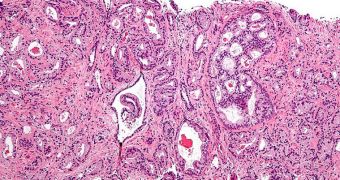A team of researchers from the US National Institutes of Health (NIH) announces that it has just awarded a $3.3 million grant to a collaboration of researchers for improving prostate cancer imaging.
The team includes researchers from the Rutgers University, the Riverside Research Institute, the Beth Israel Deaconess Medical Center, and GE Global Research.
Prostate cancer imaging technologies already exist, but the new NIH grant is awarded for developing methods of improving its reliability and results, the team says.
Tissue in the prostate is susceptible to turning cancerous later on in life, and the condition is very dangerous and difficult to treat. Catching the cancer early on is the best bet men have to survive.
In order for that to happen, urologists need to be able to quickly and precisely identify any sign of trouble in the prostate tissue, and they need access to sensitive technologies in order to do this.
Focusing on suspicious tissue is also bound to increase the efficiency of detecting the cancer when using needle biopsies, and also the effectiveness of localized treatments.
The combined approach the team will try out will revolve around the use of both Magnetic Resonance Imaging (MRI) and ultrasound technology.
One of the most commonly-used approaches in detecting prostate cancer today is using ultrasound imaging to analyze various sites in the prostate gland, and then using biopsy needles to extract samples for analysis.
But this technique is not sensitive enough to detect suspicious, cancer-prone tissue deep inside the gland. Biopsy samples may not reveal the presence of cancer even if the condition is present.
“As a result, urologists aren't always confident about ruling out cancer after a negative biopsy guided by conventional ultrasound,” explains scientist Anant Madabhushi.
The expert is a co-investigator on the NIH grant, and also an associate professor of biomedical engineering at the Rutgers University.
“The information we glean from combining the two methods could help urologists direct the placement of the biopsy needle or localized treatments to otherwise invisible cancerous tissue,” adds Madabhushi.
The expert is also a member of The Cancer Institute of New Jersey (CINJ). Statistics show that about 20 percent of the 1,000,000+ biopsies being performed annually in the US are positive.
“If we can do these biopsies in a more targeted fashion, we will be more confident that there's no cancer if the biopsy is negative,” the expert argues.
“From a patient's perspective, that would be far more comforting news,” he concluded.

 14 DAY TRIAL //
14 DAY TRIAL //